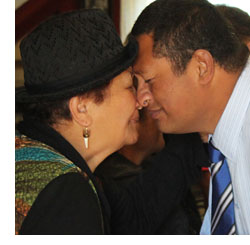Te reo Māori speakers

 TE REO MĀORI SPEAKERS
TE REO MĀORI SPEAKERS
| NO SIGNIFICANT CHANGE |
The percentage of people in the Waikato region who say they speak te reo Māori increased between 2013 and 2018 following a long decline.
This indicator is the percentage of people within the total population living in the Waikato region, who reported that they speak te reo Māori, according to the New Zealand Census.
Why is this indicator important?
The number of Māori language speakers reflects understanding of the importance of New Zealand’s cultural heritage. te reo Māori has been formally recognised as an official language of New Zealand since 1987. As the number of Māori language speakers increases, there is less likelihood of the language not being lost through lack of use. Our connection and pride in keeping the language alive can also help us to create and present a sense of identity for ourselves, our communities and our country.
Measuring the number of Māori language speakers within a population can indicate how connected Māori and non-Māori living in our region are with regional and New Zealand history; our indigenous heritage and people; and each other.
Te reo Māori speakers

| Year | Per cent Māori language speakers in the total population |
|---|---|
| 1996 | 6.3 |
| 2001 | 6.4 |
| 2006 | 5.8 |
| 2013 | 5.3 |
| 2018 | 5.9 |
Note: Denominator is total people. This includes a small proportion of people who did not state a response.
What is this indicator telling us?
- The percentage of people living in the Waikato region who said they spoke te reo Māori at the time of the 2018 Census was above the national average (5.9% compared to 4.0%). This is at least partly due to the higher proportion of Māori residents in the Waikato region.
- The percentage of Waikato region residents who recorded in the 2018 Census that they speak te reo was similar to the 2006 level of 5.8%. This followed a record low of 5.3% in the 2013 Census.
- The highest percentages of Māori language speakers in the Waikato region in 2018 were recorded in the Waitomo district (11.3%) and Taupō district (7.7%). The adjacent Rotorua district (only partly in the Waikato region) also had a high percentage (12.1%).
DATA SOURCE AND SUPPORTING INFORMATION
Census data on languages spoken is available via the NZ.Stat table builder. Numerator is number of people who speak Māori and denominator is total people (including those who did not state a response to this Census question). Data for 1996 were sourced through a customised data request.
Update details: Most recent figures are from the 2018 Census. The next Census is scheduled to occur in March 2023.
Customised data request requirements: Nil
DATA AVAILABILITY – OTHER THAN WAIKATO REGION:
Territorial Authority (TA) disaggregation: Yes
Other regions: Yes
New Zealand: Yes
Other countries/ Organisation for Economic Co-operation and Development (OECD): No




To ask for help or report a problem, contact us
Tell us how we can improve the information on this page. (optional)